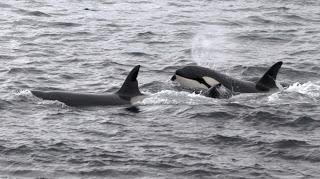
© Colin Bird/ Sea Watch Foundation
Every year, scientists at the Sea Watch Foundation lead the National Whale and Dolphin Watch – a campaign to get members of the public contributing to science to protect whales and dolphins. They are calling on people across Scotland to get involved with this year’s event, which runs from 29 July-6 August 2017.For over 40 years, Sea Watch Foundation scientists as well as volunteer observers all around the UK’s coast have been reporting on whales, dolphins and porpoises –collectively known as cetaceans – to inform Sea Watch’s huge database of records.
The scheme is one of the oldest and longest running citizen science schemes in the world. Members of the public are being asked to take part in National Whale and Dolphin Watch, the charity’s flagship summer event which is now in its 16th year. “Many people don’t realize the wealth of whales and dolphins we have around our coasts. You don’t need to go abroad to go whale watching or to have a dolphin experience,” says Kathy James, Sightings Officer for Sea Watch Foundation.
“For a few months now, killer whales have been spotted from the Moray Firth round the north of Scotland to the west coast. Large whales, possibly fin whales – second only in size to blue whales – have been spotted out in the Hebrides and reports of bottlenose dolphins have been coming in from the Moray Firth as well as south towards the border.”
Since National Whale and Dolphin Watch began in 2002, around 4,500 sightings have been made in locations from the Channel Islands and the Scillies to the Shetland Isles – encompassing places as varied as Brighton, Plymouth, Anglesey, Aberdeen, Whitby and Hull.
“You’d be surprised at what you might see even in places that aren’t designated hotspots. It’s all about getting out there to spot the animals using your patch and reporting your sightings. Even if you don’t see any cetaceans during a watch, that information is just as valuable to us, as it helps us to build a picture all around the UK,” says Kathy.
“All that people need to do to take part is to report their whale and dolphin sightings to us and to either participate in the advertised organised watches or to arrange their own. No experience is necessary!”
On Scotland’s west coast, Hebridean Whale and Dolphin Trust – which acts as a regional coordinator for Sea Watch, and which runs an extensive Community Sightings Network – says public involvement is vital to ensuring the long-term future of cetaceans in what is one of Europe’s most important marine habitats.
“Spotting whales, dolphins and porpoises in the wild is a fantastic experience – and by reporting their sightings, people can make a huge difference in helping us to map cetaceans’ distribution and inform policies to protect them,” said Pippa Garrard, the trust’s Community Engagement Officer.
“So we’re hoping that National Whale and Dolphin Watch 2017 creates a real buzz across Scotland. We’re urging people take the opportunity to get involved as citizen scientists and have a great time.”
During the nine-day 2016 National Whale and Dolphin Watch, 11 different whales and dolphins were recorded in UK waters, as well as the tiny harbor porpoise, which measures just a meter and a half when fully grown. Some 1424 sightings were logged and 7,622 individual animals included.
People are being urged to register to run watches of their own during National Whale and Dolphin Watch 2017, so that they can contribute valuable data for the protection of these magnificent species.
To find out more about the event, please visit www.seawatchfoundation.org.uk/nwdw.
To join a registered event, visit www.seawatchfoundation.org.uk/nwdw-2017-watch-list. Please note that new events are being added all the time. People can register their own watch at www.seawatchfoundation.org.uk/nwdw-2017.

